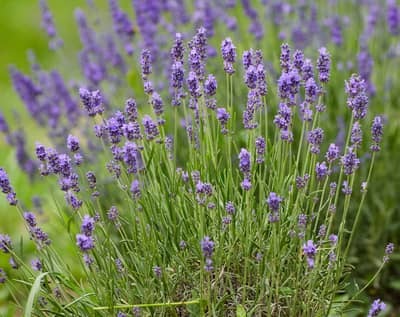There are a lot of reasons you should grow lavender indoors. For one, it’s admired for its pleasant scent, but it’s also a natural bug repellent. If you have lots of light in your house, a tightly fitted pot, and a few drops of water to spare every now & then, your lavender plant will thrive inside your home.
To grow lavender indoors, you need to replicate the hot and dry climate that lavender prefers. Native to the Mediterranean, lavender needs to be in a space where it gets around 8 hours of sunlight daily, has very dry soil that’s slightly acidic, and a pot fitted to its root ball to allow proper drainage.
You can also check out our definitive guide to indoor growing.
Where Do I Start?
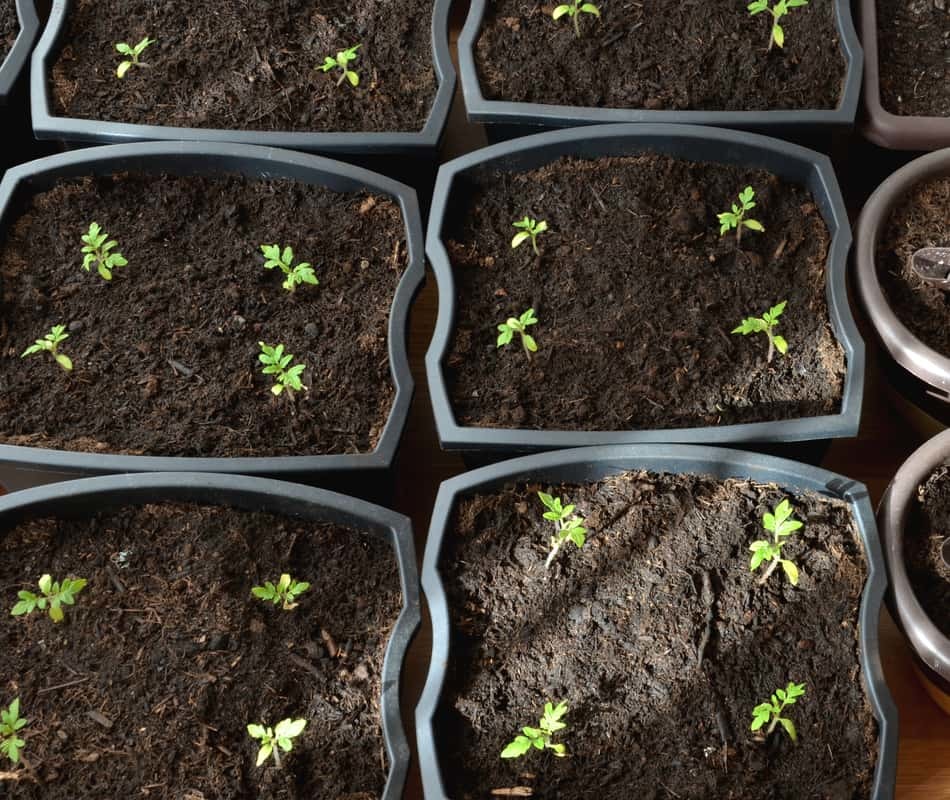
Why Should I Grow Lavender Indoors?
Lavender is popular for growing indoors because it’s a natural bug repellent.
It won’t attract any of those pests that you want to keep out of your house, but however, it does attract bees and butterflies.
These are the 2 things you do want fluttering around your lavender though.
Lavender also offers many wellness and practical benefits that can positively impact your everyday life.
Apart from that, its blue and purple flowers make a nice addition to your home.
While it may be picky and stubborn, lavender is a fairly easy plant to grow–even indoors.
Why Not Outdoors?
While lavender is equally beautiful indoors and outdoors, you’ll appreciate its benefits and everything else it has to offer even more when you grow it indoors.
If you live in a cooler or wetter region, it also might be better to grow your lavender indoors, since most types of lavender prefer warm, dry climates.
By growing lavender indoors, you can–for the most part–control the climate.
What Types of Lavender Can I Grow?
Like a lot of cultivated plants, lavender comes in a dizzying number of varieties:
- English lavender
- Blooms in mid-summer
- Adapted to cooler climates
- French lavender
- Blooms from fall to early winter
- Adapted to warmer climates
- Spanish lavender
- Blooms in mid-spring
- Adapted to warmer climates
- Munstead lavender
- Blooms in late spring or early summer (blooms twice)
- Adapted to warmer climates
- Grosso lavender
- Blooms in early summer, late summer, or early fall (can bloom 3 times)
- Adapted to warmer climates
- Canary Island lavender
- Blooms in the spring
- Adapted to cooler climates
- Fernleaf lavender
- Blooms in late spring or early summer
- Adapted to warmer climates
- Provence lavender
- Blooms in mid-summer
- Adapted to warmer climates
- Spike lavender
- Blooms in late spring
- Adapted to warmer climates
The table below give you a simple way to decide which variety of lavender works best in different situations & growing conditions:
| Purpose | Lavender variety |
|---|---|
| Best Lavender for Growing Indoors | French lavender
Why? Not very fragrant compared to other types and adapts to indoors easily. |
| Best Lavender for Growing In Small Spaces | Munstead lavender
Why? It’s a compact plant, meaning it only grows 2-3 inches tall and wide. |
| Soonest to harvest | Spanish lavender
Why? This type of lavender can bloom as early as mid-spring, meaning it may be able to be harvested in early spring. |
| Best for Warm & Southern Climates |
Grossolavender
Why? Grosso lavender thrives best in full sun and dry and poor soilconditions. |
| Best for cooler & Northern Climates | Canary Island lavender
Why? This is one of the few types of lavender that’s adapted to coastal climates. |
When Should I Plant Lavender?
It’s best to plant lavender at the very beginning of spring, once winter is pretty much left the building.
It’s important not to plant lavender when it’s still winter because it won’t get the sunlight it requires.
Better to wait until either late winter or early spring, when the days are beginning to get longer.
Lavender takes 1-3 months to fully grow as long as it’s getting what it needs.
This means they’ll begin flowering anywhere from the end of spring to early summer, though exact flowering dates will depend on the type of lavender, growing conditions, etc.
Your mileage may vary.
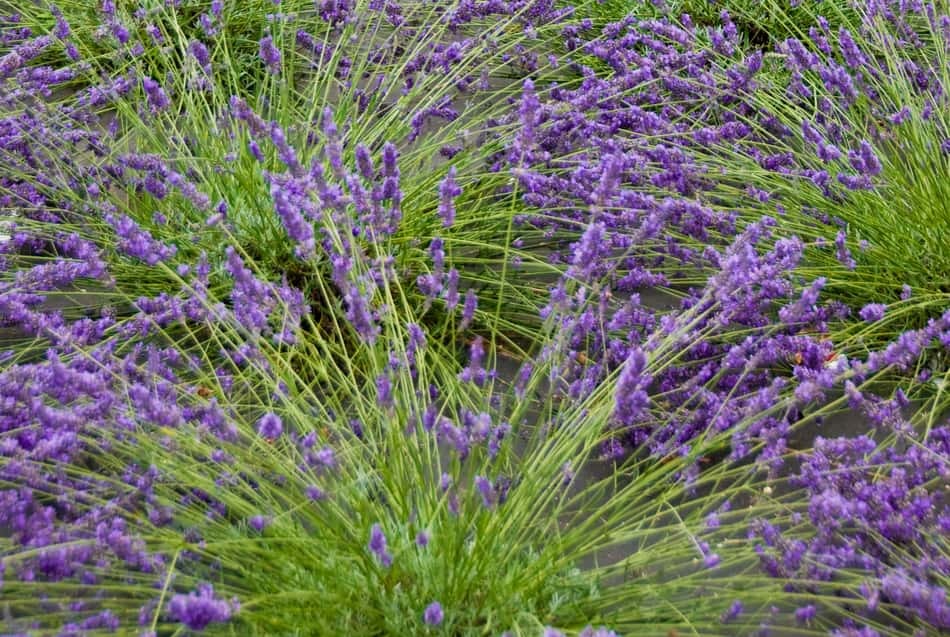
Where Should I Plant Lavender?
For planting indoors, it’s ideal to use a pot that’s roughly the same size as the root ball (if you’re transplanting), or large enough to accommodate the fully-grown plant–at least a 1 gallon pot. Using a pot that’s large enough will prevent the roots from getting waterlogged.
Remember: Lavender thrives in dry, warm soil, so give it what it wants.
Speaking of warm climates, put your lavender in a sunny spot–full sun, all day (if possible) is best.
It’s also a nice idea to plant your lavender somewhere where it’s visible. No point growing it if you can’t enjoy its flowers or scent.
What Do I Need?
The first thing you’ll need when planting lavender is some seeds. You can purchase lavender seeds at any local gardening store or even grocery store.
If you prefer, you can use organic seeds to support organic farming methods.
But keep in mind that organic crops can be grown with conventional seeds.
That’s because organic crops are defined by the methods used for growing–not by their seed source.
Anywho, once you have your seeds, find a seed tray or small container and fill it with soil.
When your lavender has sprouted leaves, that means it’s time for it to get a place of its own.
You can move it into a pot that offers good drainage.
Starting Seeds & Seedling Care
Seed Starting Tips
To get the best results from your lavender seed, make sure you don’t completely cover the seed in the soil.
Lavender seeds actually need to be exposed to light to germinate.
Yep, it might seem strange, but some seeds require light before they’ll germinate–poppies & lettuce are others that require light for germination.
Another trick for getting seeds to germinate better is to trick the seeds into thinking they’ve been through winter.
To do that, mix your seeds in a plastic baggie with soil and enough water to make it damp but not soggy.
Put the mixture in your fridge for 6-8 weeks, and you’ll typically get better germination.
OK, next, make sure you keep the seed in a warm climate.
By a window or in a warm, sunny room are ideal locations.
Also, ensure that you’re keeping tabs on the soil. If it becomes damp or wet, you need to find your seed a new home so it can properly germinate.
The seeds can take anywhere from 2 weeks to one month to germinate.
For faster germination, ensure that the soil is dry and it’s receiving lots of light.
The ideal soil conditions for lavender are dry and slightly acidic. The pH should be around 6-7.
To keep your soil at the pH levels it needs, one tip is that you can add some elemental sulfur into it once every year.
Special Seedling Care
When planting lavender seeds, a seed tray or small container is recommended.
Place one seed per seed tray slot, or one seed per container. Or, at the least, keep them 16 inches apart.
Lavender tends to grow in bushes, so make sure it has its own room to grow!
Some types are smaller bushes than others, but lavender still prefers its personal space.
For improved and possible accelerated germination, add a little bit of compost to the soil.
Not too much though, because lavender grows the best in poorly fertile soil.
Care & Maintenance
Sunlight
Since lavender likes hot & dry climates with lots sun, give ’em what they want. Typically, 8 hours of sunlight per day is good.
If your lavender plant isn’t getting enough sun, you might want to buy supplemental grow lights.
The advantage here is that by having grow lights, you can extend the growing season for any of your other indoor vegetables, like tomatoes or peppers.
Soil
Keep the soil of your lavender dry and only moderately fertile.
It’s recommended to even add builder’s sand to improve drainage and dryness of the soil.
The pH should be on the slightly acid side–around 6-7.
Fertilization
Like with water, lavender needs very little fertilizing.
Fertilize it at the beginning of the growing season, so early springtime, and place a small portion of compost around the plant.
After that, your plant is good to go until the next year.
Water
Only water your lavender plant every couple of days.
If the soil is very dry and has gone several days without water, give it some water.
If it’s very damp or wet then repot it with dry soil.
Pruning
Lavender needs to be pruned during the springtime, just before it’s about to flower.
Take some shears and cut off the stem right up to the flower buds to keep your plant healthy and clean.
Common Problems & How to Fix Them
Too Little or Too Much Light
If your lavender plant is receiving too little or even too much light, this will become a problem.
You may notice the plant starting to droop and wilt because it’s not getting the right amount of sunlight needed to thrive.
If this is the case, you can prevent this by keeping track of how long it’s in the light.
Too much sunlight typically isn’t a problem, unless you live above the Arctic circle or want to try your hand growing lavender at McMurdo Station in the Antarctic (though, it’s a huge no-no to introduce alien species).
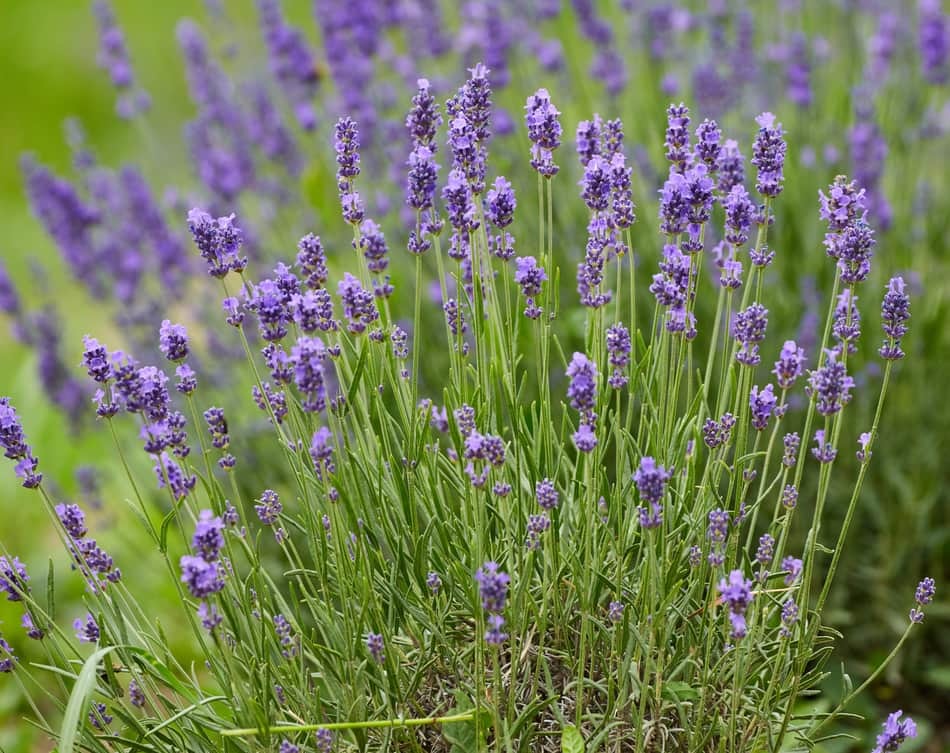
Over- or Under-Watering
Over-watering your plant is a common problem when growing lavender, but under-watering can also be too.
If you’re watering your lavender more than every couple of days and the soil is damp, cut back on the watering time.
If you’re not watering your lavender plant for weeks at a time, try and make it a routine to give it a little water every five or so days.
Woody Appearance
If lavender isn’t pruned, it’ll get woody.
So, prune lavender, ideally during spring.
Not only does pruning improve its appearance, but pruning can stimulate additional flowering.
Black Root Rot
Among lavender plants, black root rot is the most common disease.
As the name implies, black root rot causes the lavender plant to rot from the roots up.
It occurs when the plant is in overly wet conditions.
This is the environment that the pathogen in black root rot thrives in.
This can be avoided by making sure you don’t over-water your plant.
Here are black root rot’s symptoms:
- Drooping, yellowing leaves
- Splitting stem
- Lavender turns brown or black
Alfa Mosaic Virus
This virus can contaminate your lavender plant through infected insects or hands.
Make sure you wash your hands before touching the leaves or wipe down the leaves afterward contact with it.
Here are some symptoms that your lavender plant may have this virus:
- Yellowing leaves
- Curling leaves
Shab Disease
Shab disease is a fungus that targets the stems of lavender plants.
Like most diseases that attack plants, this can be avoided by proper care of your lavender.
Giving it the right amount of water and sunlight, and an environment that isn’t infected is the best you can do to prevent diseases like Shab disease.
The symptoms for Shab disease, like the others, are easy to spot if you keep an eye on your lavender:
- Sudden wilting of shoots
- Small black shapes on bark
Spittlebugs & Froghoppers
While lavender’s scent deflects many pests, the spittlebug and froghopper are two that suck the sap from the lavender plant.
While these two insects don’t pose a high amount of danger to the plant, it’s still a good idea to get rid of them.
A simple vigorous spray from a hose will do the trick.
Harvesting & Using Lavender
When & How Should You Harvest Lavender?
The answer here depends on what you want to use lavender for:
- Do you want dried flowers?
- Or, do you want lavender essential oil?
To harvest lavender, all you need to do is use some shears to cut the stems just above the woody growth at the bottom, and voila, you have harvested lavender!
Check out our complete guide for harvesting lavender for flowers, tea, oil–plus our tips & tricks.
Harvesting lavender for dried flowers
So, this is pretty easy: if you want dried flowers, harvest lavender when about half the flowers on the stem have opened.
This way, the dried lavender will continue to be fragrant after its dried.
Any later, and you’ll have too many dried buds on the stem.
Harvesting lavender for its essential oil
To get the maximum amount & highest quality lavender essential oil, harvest lavender when all flowers on the stem have opened, and only a few have withered.
That way, the stem and its flowers have the maximum amount of essential oil.
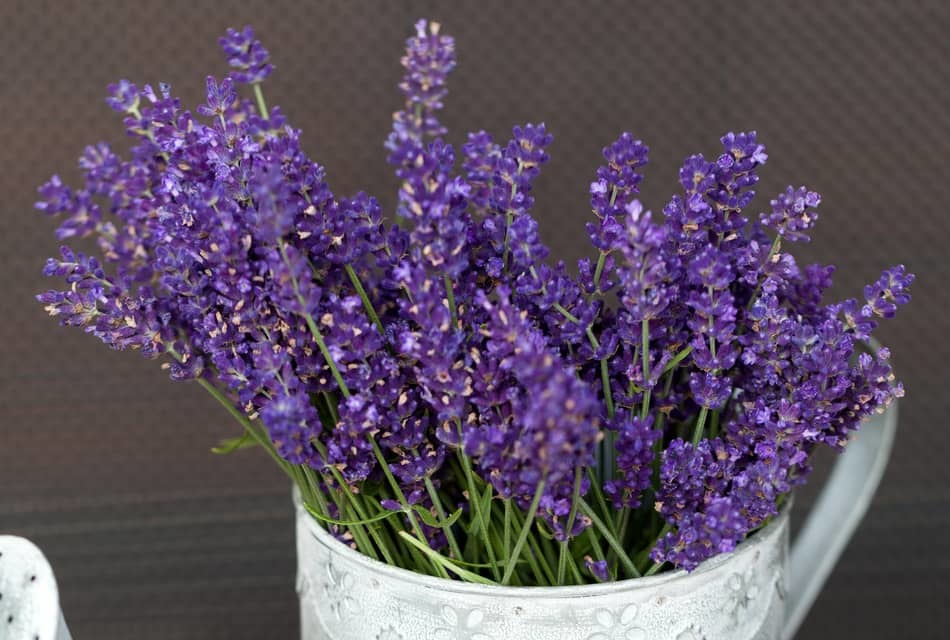
How Should I Use Harvested Lavender?
Once you have harvested your lavender, from aesthetics to wellness, the list of things you can do with lavender is seemingly endless.
Dry It Out
One thing people often do with freshly harvested lavender is dry it out.
Tie the cut stems together and hang it somewhere until it’s fully dried.
Once it has, you can hang the bundle somewhere for the scent or massage it into your skin to heal it.
Dried lavender is usually good for 2-3 years, but to ensure it lasts that long try to keep it out of the sunlight.
Beauty
Lavender-based or scented products are super popular.
From lip balms to bath balms, you can easily purchase them from the stores or even try out a variety of DIY recipes that include it.
Here’s a simple recipe for lavender body scrub–it’s great for rejuvenating your skin:
What You Need:
- ½ cup coconut oil
- ¼ cup granulated sugar
- ¼ tsp. lavender essential oil
- small container (glass is preferable to plastic)
Make It:
- Combine ingredients in a bowl
- Spoon into a container for storage
- Rub into arms, legs or any other needed areas
Healing
Lavender is also known for speeding up the healing process.
In addition, lavender’s antibacterial properties make a good salve that can be applied to burns and soothe itchy bug bites.
What You Need:
- 4 oz of olive or coconut oil
- 0.5 oz of beeswax
- dried lavender or essential lavender oil
- heatproof jar or tin containers
Make It:
- Melt beeswax in a saucepan or in the microwave (low heat preferred)
- Add the oils and dried lavender
- Pour into jars or tin containers
Food
On a completely different side, lavender is also commonly used for flavoring foods.
Simply grind up the lavender like you would any herb.
Often in dishes, it replaces rosemary, or it can be a pretty decoration to a meal.
Lavender can also be put in lemonade or other drinks to add just a little more flavor to it.
Apart from growing it in your garden (indoors or outdoors), culinary lavender can also be purchased from almost any grocery store.
Related Questions
Why Is My Lavender Plant Dying?
If your lavender plant is dying it might be getting too much or too little light, it’s overwatered, or its soil is low nitrogen.
These are easy enough fixes though. Just ensure your lavender is getting its 8 hours of sunlight, has dry soil, and has fish emulsion or blood meal to increase nitrogen levels.
Benefits of Growing Lavender Indoors
There are many benefits to growing lavender indoors such as improved sleep, decreased stress levels, and its natural bug repellent.
The peaceful scent also wards off pests that you don’t want nibbling on your plant or in your house making it ideal to grow indoors and outdoors!
How Do I Use Lavender?
There are many uses to lavender such as using it replenishes your skin, makes a beautiful addition to your home decor and has a scent perfect for aromatherapy.
Not only do its flowers visually appease the eye or its scent calm the nerves, but its antibacterial properties also clean and soothe worn skin.

